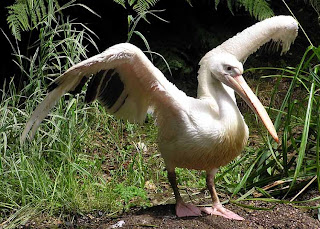
The White Pelican, Pelecanus onocrotalus also known as the Eastern White Pelican or Great White Pelican is a bird in the pelican family. It breeds from southeastern Europe through Asia and in Africa in swamps and shallow lakes. The tree nest is a crude heap of vegetation.
This is a large pelican, at a mass of 10 kg (22 lbs), 160 cm (63 in) long and with a 280 cm (110 inch) wingspan. It differs from the Dalmatian Pelican, the only larger species of pelican, by its pure white, rather than greyish-white, plumage, a bare pink facial patch around the eye and pinkish legs. Males are larger than females, and have a long beak that grows in a downwards arc, as opposed to the shorter, straighter beak of the female. Immature birds are grey and have dark flight feathers.
More than 50% of White Pelicans breed in the Danube Delta. This pelican migrates short distances, wintering in northeast Africa. In flight, it is an elegant soaring bird, with the head held close to and aligned with the body by a downward bend in the neck.
Pelicans catch fish in their huge bill pouches, most, like this species, while swimming at the surface.
Like the Dalmatian Pelican, this species has declined greatly through habitat loss and persecution.
The White Pelican is one of the species to which the Agreement on the Conservation of African-Eurasian Migratory Waterbirds (AEWA) applies.
There is a group of about five semi-wild pelicans living on Pelican Island, St. James's Park, London. Their ancestors were donated to the United Kingdom by foreign ambassadors.
This is a large pelican, at a mass of 10 kg (22 lbs), 160 cm (63 in) long and with a 280 cm (110 inch) wingspan. It differs from the Dalmatian Pelican, the only larger species of pelican, by its pure white, rather than greyish-white, plumage, a bare pink facial patch around the eye and pinkish legs. Males are larger than females, and have a long beak that grows in a downwards arc, as opposed to the shorter, straighter beak of the female. Immature birds are grey and have dark flight feathers.
More than 50% of White Pelicans breed in the Danube Delta. This pelican migrates short distances, wintering in northeast Africa. In flight, it is an elegant soaring bird, with the head held close to and aligned with the body by a downward bend in the neck.
Pelicans catch fish in their huge bill pouches, most, like this species, while swimming at the surface.
Like the Dalmatian Pelican, this species has declined greatly through habitat loss and persecution.
The White Pelican is one of the species to which the Agreement on the Conservation of African-Eurasian Migratory Waterbirds (AEWA) applies.
There is a group of about five semi-wild pelicans living on Pelican Island, St. James's Park, London. Their ancestors were donated to the United Kingdom by foreign ambassadors.

No comments:
Post a Comment